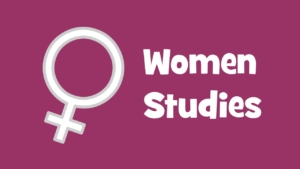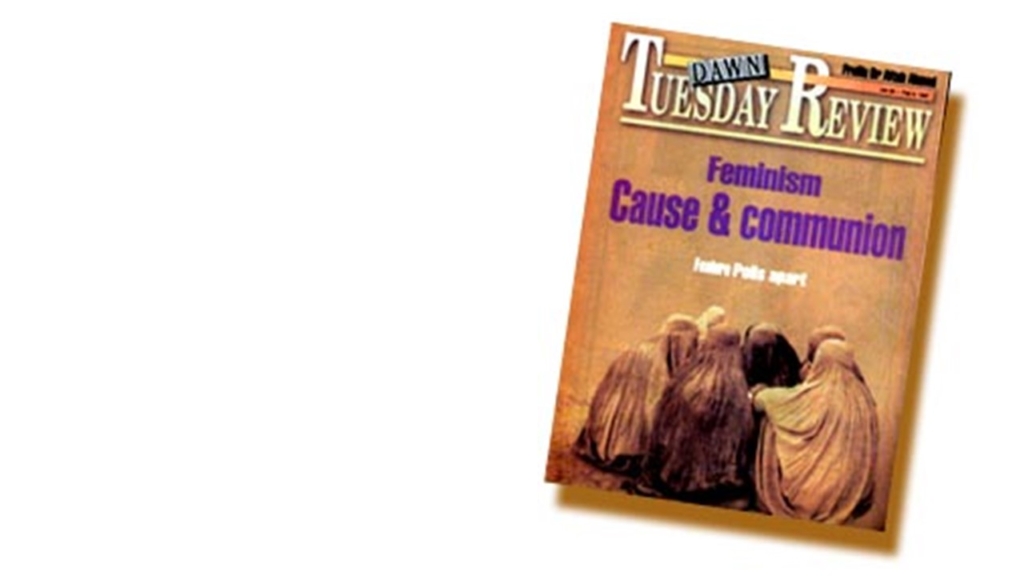Dawn, Tuesday Review, February 3-9, 1997
 Feminism is just as difficult to define as communism – perhaps more. While definitions abound in books, most feminists agree that feminism has got something to do with (a) a perception that the existing male-dominated society (patriarchy) oppresses women, and (b) a commitment to do something about it.
Feminism is just as difficult to define as communism – perhaps more. While definitions abound in books, most feminists agree that feminism has got something to do with (a) a perception that the existing male-dominated society (patriarchy) oppresses women, and (b) a commitment to do something about it.
It is difficult to say when the idea first appeared. Anthropologists believe there was once a time when society was female-dominated (matriarchy).
Perceptions of matriarchy differ too. Some would imagine Amazons, or warrior women, ruling over subdued males. Others would imagine a jungle where human beasts satiated their carnal desires and males turned their backs upon women sooner after satisfying those cravings, thus leaving the better halves alone to carry the burden of pregnancy and child-rearing. Some feminists tend to imagine that life in the matriarchy was just as peaceful and lovely as in the Garden of Eden, or in Rousseau’s State of Nature. The maternal values of care and sympathy ruled over a society where greed, jealousy and selfish lust were unknown.
Whatever might have been the case, we know that if there ever was such a universal matriarchy it was abolished long before the birth of civilization. Even the Stone Age cultures are today believed to have followed patriarchal norms at least as far as the question of supremacy was concerned. The feminist anthropologists, however, point out that women played just as much an active part in the birth of the civilized world as did men, or perhaps more.
Legends of strong women come down to us through early history. Almost all polytheistic societies worshipped goddesses. Most of them cared to keep “fertility figurines” – this glorification of the pregnant female form is quite a feminist idea, and might have been reminiscent of some bygone matriarchy.
In ancient literature we find such images as Electra, who revenges her father’s slaughter, and those Trojan Women – while some would point them out as expressions of psychological fears in the minds of male playwrights, others would liken them to interpret as leftovers of a lost tradition.
Likewise, the history of Mary (Bibi Marium) has been interpreted by some feminists as the story of a woman who defied the use of patriarchal tags to mark her identity.
In the Semitic religions, which seem to have a tradition of male prophets and a patriarchal God, we nevertheless find references to the feminine face, or the female attributes of God. These occur as ‘Shekhinah’ in Judaism and ‘Sophia’ in Christianity. In the Islamic traditions, Ibn-e-Arabi and various mufassireen have noticed the common linguistic roots of ‘Rahman’ (one of the highest attributes of Allah) and the Arabic word ‘rahm’ (meaning womb). Almost all Islamic books draw a parallel between Allah’s mercy and maternal care. Hence all ancient faiths had a tendency to appeal to both men and women in one manner or another. (An indication of their divine origin?)
This was not the case with the modern enlightenment (eighteenth century). The champions of human rights who drafted the constitutions of France and America would fall off their chairs laughing if somebody asked whether the human rights also included women’s rights. The sexist language was a wonderful thing: “All men are equal” could be taken at its face value but “Any man committing murder should be executed” were to be interpreted in generic terms!
The egalitarian society formed on humanistic principles might have been a very rational thing but it practically kept women out. They were not allowed to cast votes, leave alone holding office.
The reaction of women (and some men) is known as the First Wave Feminism. Mary Wollstonecraft (1759-97) was one of the first writers to link liberalism with feminism, an idea that was passionately brought forward in A Vindication of the Rights of Woman (1792).
After leading a short life of 38 that included involvement in the French revolution and several love affairs, she died while giving birth to her second daughter (who would grow up to become Mary Shelley). While the next generation of her countrymen forgave similar behaviour of the male romantics, her sins were well-remembered and brought an early bad repute to the name of feminism. The idea, however, evolved into suffragist movements that had taken form on both sides of the Atlantic by the middle of the nineteenth century.
In spite of the eloquently written classic of the parliamentarian social philosopher J.S. Mill (On the Subjection of Women, in 1869) few people took the idea seriously well until the beginning of the present century when the charismatic Emmeline Pankhurst formed the Women’s Social and Political Union in 1903.
The achievement of the right to vote was still a matter of another fifteen years of militancy in which thousands of women were to break the law and go to jail to prove their determination. Women over the age of thirty (as compared to men aged 21) were given the right to vote in Britain in 1918. America adopted the principal of equal suffrage in 1920, and eight years later the British government also amended its previous rule to grant suffrage to women at the same age as men. It is a strange thought to consider that while Queen Victoria reigned as the decorative Empress, not a single woman of her country was entitled to cast an ordinary vote. Or, that, when the black slaves were freed after the Civil War and given the right to vote, their former mistresses were still not entitled to enter the polling stations. Or, that if it were not for such rowdy women as Pankhurst and her band of law-breakers, the women of Britain, India and Pakistan could have been living without having their say even to this day since the rules of female suffrage were automatically extended over the British colonies as a part of constitutional reforms there. The women of Pakistan, entangled with debates about their status before law, at home and in society, have a direct reason to thank the souls of feminists like Pankhurst who freed them from the chain of suffrage.
While the liberal feminists, best represented by J. S. Mill and Pankhurst, believed that the oppression of women can be eliminated through adequate legal provisions, there was another school of thought which disagreed with this view on philosophical principles.
Friedrich Engles (1820-95) had propounded as early as 1884 that the plight of women is not a case of “oppression” but that of “exploitation.” In his book The Origin of the Family, Private Property and the State, he had maintained that men have come to consider women as a kind of property and therefore the inequality between the sexes cannot be eliminated as long as capitalism is in place. This idea developed into the Marxist Feminism, which suffered an unfortunate fate since in Marxism the class struggle took precedence over the struggle to free women. “The woman question” was thus sidelined with the evolution of Marxist ideology.
The period following the Second World War witnessed remarkable upheaval in the intellectual texture of the world. The Second Wave Feminism came in as the essential counterpart of the new consciousness of man. It is difficult to point out the exact beginning, but a good many observers sense a connection between the new women’s movement and the publication of Doris Lessing’s novel The Golden Notebook (1962). This seems rather like a “forced marriage” – while the feminists feel embarrassed to link the birth of an overwhelming movement with a single piece of fiction, the author of the novel is herself quite reluctant to limit the scope of her book to just one political idea, and refuses to identify herself with feminism. Nevertheless, the 1960s did mark the creation of a new female consciousness. If the aim of the First Wave Feminism was to achieve political equality, the aim of the second was total equality – spiritual, social, psychological and biological. This was a massive undertaking indeed.
It meant looking back on virtually each and every domain of knowledge, and rewriting all the canons of human understanding on the basis of gender equality. How can you ensure psychological equality if the books of psychology you have were written by Freud, Jung, Pavlov, Maslow – all men? How can you ensure spiritual equality if all the prophets you quote were men? The challenges faced by the feminists of the Second Wave were immense. However, in this case (just as in the First Wave) the effort justifies the ambition. Over the last thirty to thirty-five years we have come to possess a body of knowledge that is enough to fill entire libraries on its own (which is already happening, with the establishment of women’s studies centers all over the world). The feminists have provided new ways of looking at areas of information such as religion, language, history, media and the life sciences – and many more. In most instances, these subjects have been re-interpreted and re-shaped by the feminist scholars.
Nothing could be farther from the truth than to say that feminism is about sexual promiscuity, irreligious attitude and disorder in society. Just as the knowledge of philosophy is not a commitment to turn your back on religion. Just as the study of biology is not the name of casual sex. Feminism is much more than what it is sometimes misunderstood for.
 This articles is part of the series “Women Studies”: Let’s say no to a peurile feminism | Women and cinema in Pakistan | Women as prophets in the Quran | A woman’s Islam? | Gender roles in education | Women’s right to divorce in Islam | Liberty, equality, fraternity | In religion’s wake | ‘Men are from Mars, women are from Venus … no more’ | ‘History, she wrote’ | ‘Debunking myths‘ | Women in the Quran | Portrayal of women in the stories of Sadat Hasan Manto
This articles is part of the series “Women Studies”: Let’s say no to a peurile feminism | Women and cinema in Pakistan | Women as prophets in the Quran | A woman’s Islam? | Gender roles in education | Women’s right to divorce in Islam | Liberty, equality, fraternity | In religion’s wake | ‘Men are from Mars, women are from Venus … no more’ | ‘History, she wrote’ | ‘Debunking myths‘ | Women in the Quran | Portrayal of women in the stories of Sadat Hasan Manto
